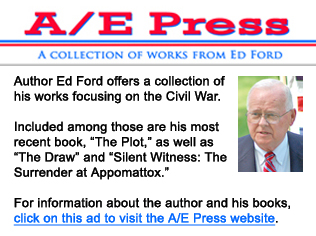|
Civil War communication prospered
because of Louisville’s Norvin Green
By BRYAN BUSH
Bugle Staff Writer
There was at least one thing upon which the Union and Confederacy could agree. Civil War communication would be virtually impossible without the transcontinental telegraph. And that was possible because of pioneers such as Louisville’s Norvin Green.
 Green was a successful doctor and politician, but his contribution to communication with the expansion of the telegraph had an immense impact on the Civil War. Green was a successful doctor and politician, but his contribution to communication with the expansion of the telegraph had an immense impact on the Civil War.
Before 1861, troops could only communicate with their field commanders by signal corps or runners on foot or horseback. With the telegraph, field commanders could stay in touch with their superiors in Washington or Richmond. Reporters could quickly dispatch news from the battlefield to their newspapers and magazines.
By the time of the Civil War, the telegraph brought the nation together from the east coast to the west coast. With the Southern Telegraph Company in Louisville, field commanders could telegraph vital information from the field to their commanders in Louisville and from there relay the information to Washington. The Southern Telegraph company began an integral part of the war in the Western Theater, and the Union army had Norvin Green to thank.
A true American entrepreneur, Green began finding ways to earn money at age 16.
He bought a flat boat and determined to try his luck running a floating grocery store from Louisville and down the Mississippi. His primary customers were lumberjacks. The trip was a success and he received a good amount of orders that had to be sent by steamboat. His credit was good and all of his orders were honored. The lumberjacks wanted iron boots and Green made a profit from selling the boots.
Green also ran a successful business chopping and selling firewood. The money he earned from his businesses allowed him to pay for a medical education. He studied under a local doctor, and eventually resumed his studies at the University of Louisville. In 1840, he graduated from the University of Louisville with his medical degree and started a successful practice. He later became physician of the Western Military Academy in Drennon Springs, then turned his attention to politics.
He was elected for several terms to the Kentucky legislature and in 1853 he was appointed Commissioner of the United States in charge of the construction of the Customs House and Post Office in Louisville. While engaged in his duties, he became one of the lessees of the “United New Orleans and Ohio,” also known as the Morse line and “The People’s” telegraph line between Louisville and New Orleans. After he became president of the company, he united it under the name of the Southern Telegraph Company.
Both lines started from Louisville and passed through Nashville into Middle Tennessee, where they divided. The Morse line went to Somerville, Tenn. with a branch to Memphis, Juanita, and Potontoc to Greenville, Miss. and from there the lines went down the Walnut Ridge to Vicksburg, Grand Gulf, Natchez to Baton Rouge, La.
The People’s line went from Lawrenceburg to Tuscumbia, Ala., Columbus, Canton, Jackson, Gallatin, and Liberty, Miss. to Baton Rouge and then to New Orleans. After Green consolidated the company into the Southern Telegraph Company, he forever became identified with the history of the telegraph.
The telegraph helped transform warfare. Both the Union and Confederate armies used it and telegraph wires enabled field commanders to remain in constant touch with their bases, to learn quickly of changing developments and to rectify shortages of men and materials as they occurred. Telegraphs enabled commanders of armies divided by thousands of miles to coordinate their activities. For the first time, governmental leaders had direct contact with their commanders in the field.
Both Union President Abraham Lincoln and Confederate President Jefferson Davis corresponded with their commanders, almost on a daily basis. Reporters from newspapers and magazines kept the public informed about action in the field. The New York Times had a Louisville correspondent who used the telegraph wires to keep the eastern coast informed about the war in the western theater.
Civilians strung about 15,000 miles of wire and transmitted and received an estimated 3,000 messages a day during the war. By 1864, the Union Military Telegraph Service was using more than 6,500 miles of wire, with 76 miles of underwater cable.
Telegraph lines also were used to eavesdrop on and mislead their enemy. Confederate Gen. John Hunt Morgan took soldier-telegrapher George “Lightening” Ellsworth, on raids into Kentucky. Ellsworth learned the tapping habits of other telegraphers and skillfully tapped in the Green’s telegraph lines to intercept orders sending Union cavalry and infantry in pursuit of Morgan and to send misleading information on the location of Morgan’s raiders. Ellsworth even sent messages between Morgan and Chief Editor George Prentice of the Louisville Journal.
By 1866, the Southern Telegraph Company and the American Telegraph Company were consolidated into the Western Union Telegraph Company and Dr. Green was chosen vice president. The Western Union owned 75,000 miles of telegraph line and had eliminated all of their competition. With the exception of about three years, during which Green accepted the presidency of the Louisville, Cincinnati, and Lexington Railway Company, he retained the office until January 1873, when he returned to duty as vice president of the Western Union.
In 1878, Green became President of the Western Union. He was also a member of the Telegraphic Mutual Benefit Association and helped to improve the telegraphic service. He was also founder of the American Institute of Electrical Engineers and from 1884-1885, he was the organization’s first president.
Green died Feb. 12, 1893 in his house in Louisville after amassing a fortune of more than $2 million in stock and real estate. He was laid to rest at Louisville’s Cave Hill Cemetery.
|



